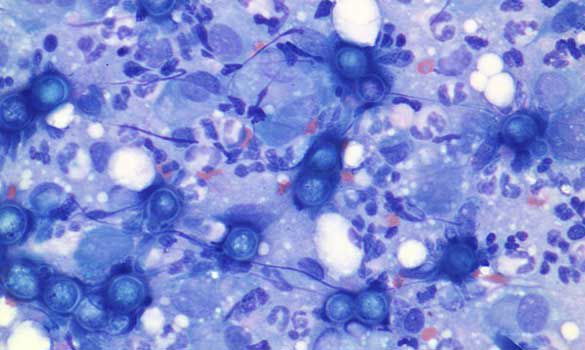Clinical Pathology Case Study: Blastomycosis in a dog
Background information
| Age: | 2 years old |
| Sex: | Male |
| Species: | Canine |
| Breed: | Mixed |
| History: | Lethargic with a persistent cough |
Clinical signs
- The cough began as a dry hacking sound two weeks earlier, and progressed to a moist productive cough over the past 3 days.
- Radiographs reveal a mild interstitial pattern throughout the lungs. A severely consolidated left caudal lung lobe was also detected.

An aspirate of the consolidated lobe that was performed.
Cytologic description and interpretation
The aspirate is highly cellular with a mixture of non-degenerate neutrophils and epithelioid macrophages. Large numbers of 12-15um round basophilic yeast with a thin wall are present and often found in pairs.
Interpretation: Pyogranulomatous inflammation with Blastomyces dermatitidis yeast (Blastomycosis).
Discussion
Blastomycosis (Blastomyces dermatitidis) is a systemic fungal infection acquired from soil, most notably in river valleys of the Eastern United States and parts of Canada. After infection establishes itself in the lungs, it disseminates throughout the body. Skin, eyes and lymph nodes are the most common sites of dissemination in dogs but any tissue can be affected. While mostly found in dogs, infection has also been reported in cats and other species.
Cytologic identification of the yeast from skin nodules and lymph node aspirates is a quick and reliable method of diagnosis, although organisms are not always present. Lung washes can also produce a cytologic diagnosis but less reliably: only 40% of confirmed respiratory cases reveal organisms with lung washing.
Other diagnostic options include urine antigen testing (a quantitative, non-invasive and sensitive method) and PCR testing (sensitive method if the sample contains organisms). Serology is often inadequate for diagnosing Blastomycosis with low sensitivity. Culture is not recommended since the cultured form is zoonotic and most veterinary laboratories are not licensed for this procedure.
Treatment of Blastomycosis predominantly relies on azole medications and is often prolonged, lasting months. The prognosis is variable, depending on the severity of the initial infection and the tissues affected.
About the author
Julie Webb DVM, DACVP
Dr.Webb is a native of Ottawa and received her DVM from the Ontario Veterinary College in 2003. She practiced in the Ottawa area for 2 years before pursuing a residency in clinical pathology at the University of Georgia. She became a Diplomate of the American College of Veterinary Pathologists in 2008 and worked as a clinical instructor at the University of Wisconsin-Madison from 2008 to 2015: performing diagnostic service, training residents and teaching veterinary students. She joined IDEXX in February of 2015.
In her spare time, Dr. Webb enjoys spending time with her dogs and staying active by cycling, swimming, and playing hockey and soccer. She also enjoys gardening in the summer as well as working with stained glass during the winter months.
Should you have any questions about this case or wish to discuss the diagnosis in greater detail, please do not hesitate to contact the author.
View clinical pathology case studies
NEW: Dermatophytosis in a dog, by Caroline Piché, DMV, IPSAV, MSc, Diplomate ACVP
Anaplasmosis in a dog, by Julie Webb, DVM, DACVP
Blastomycosis in a dog, by Julie Webb, DVM, DACVP
Cryptococcus in a dog, by Carrie Flint, DVM, DACVP
Cutaneous mycobacteriosis (Leprosy) in a cat, by Natalie Kowalewich, DVM, DACVP
Demodex in a dog, by Brittney Fierro, DVM, DACVP
Feline infectious peritonitis in a cat, by Heidi Peta DVM, MVSc, DACVP
Mammary fibroepithelial hyperplasia in a young cat, by Emmeline Tan, DVM, DVSc, DACVP
Microvascular dysplasia in a dog, by Cathy Monteith DVM, MVSc, DACVP
Severe hyperglobulinemia in a dog, by Sébastien Overvelde, DVM, MSc, DACVP
References:
- Legendre, AM. Blastomycosis. In: Infectious Disease of the Dog and Cat, 3rd ed., 2006, p. 569-576
- Spector D, et al. Antigen and antibody testing for the diagnosis of blastomycosis in dogs. J Vet Intern Med 2008;22:839–843.
- Hawkins EC, DeNicola DB. Cytologic analysis of tracheal wash specimens and bronchoalveolar lavage fluid in the diagnosis of mycotic infections in dogs. J Am Vet Med Assoc. 1990 Jul 1;197(1):79-83.
All case studies were prompted by real submissions to IDEXX Canada pathologists at one of our reference laboratories.
To protect the confidentiality of our customer and client, the background information has been slightly modified.